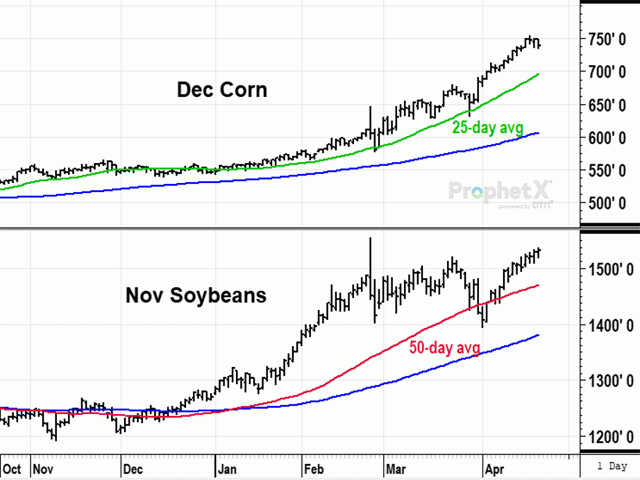Todd's Take
Winds Of War, Drought Push New-Crop Corn, Soybean Prices Higher
As I try to digest all the events pertaining to grain prices the past several weeks, it seemed that every conversation came back to the phrase, "Well, it all depends on what Putin does from here."
Will things get worse? Will things get better? A lot depends on Russia's President Vladimir Putin.
It also depends on weather.
Earlier this year, Brazil's soybean crop took the first serious hit from drought that it has seen since 2012. USDA estimates a national yield of 45.5 bushels per acre for Brazil's soybeans in early 2022, down 14% from last year's 52.9 bushels per acre. Going back to 1985, this was only the fourth time Brazil's soybean yield has dropped by more than 10% from the previous year. Droughts during Brazil's rainy season are not common events, and La Nina had a hand in this one.
For the U.S., DTN's seasonal forecast expects the current split of drier weather in the Western Corn Belt and wetter conditions in the Eastern Corn Belt to generally continue through June with higher-than-normal temperatures starting in May. In July and August, however, below-normal precipitation and above-normal temperatures are anticipated throughout the entire Corn Belt. The seasonal forecast can change, but if the current summer scenario proves out, even crops in the Eastern Corn Belt will be stressed.
The war in Ukraine and all the uncertainty that goes with it, tight energy supplies and off-the-chart fertilizer prices, continual frustrations with shipping and congested ports, and the possibility drought in South America could be followed by drought in the U.S. all combine to suggest new-crop corn and soybean prices near their highest levels in nine years may not be done going higher yet.
P[L1] D[0x0] M[300x250] OOP[F] ADUNIT[] T[]
In this market environment, DTN has not made any recommendations for new-crop sales and may not this year. For those that have ventured out and sold futures contracts, it is important to be prepared for the possibility of larger-than-expected margin calls this summer. (See DTN's Todd's Take from March 18 at https://www.dtnpf.com/….)
The main concern I have is Vladimir Putin. Here is a guy that has no qualms about bombing civilian neighborhoods, Red Cross stations or even maternity wards. His soldiers freely rape, pillage and murder -- part of the plan of terrorizing Ukraine into surrendering. Many in the media recognize Russia is intent on securing eastern Ukraine, linking up with Crimea and controlling the southern port of Mariupol, but what makes us think he will stop there?
On Wednesday, DTN Contributing Analyst Elaine Kub raised the dilemma of not knowing how far an unstable person will go, especially when the person has access to nuclear weapons. (See https://www.mydtn.com/….)
I share Kub's concern.
On the same day, numerous media outlets reported Russia test-launched a Sarmat intercontinental ballistic missile, designed to carry multiple nuclear warheads and evade missile defense systems. (See https://www.reuters.com/….)
Of course, Putin is using his tactics and Wednesday's launch to send a not-so-subtle message to the West: "Don't get in my way; I'm crazy enough to use this thing." I'm not advocating anyone panic, but this is no time to be holding futures positions on the board, even if they are hedges.
Obviously, I can't guarantee what is going to happen, but I have to point out that this could be a situation that wishful thinking can't solve. Multiple factors are already in place and have turned grain and oilseed prices more bullish than most of us anticipated last fall. The possibility of a U.S. drought and/or threat of an escalated conflict could throw this market into a whole other gear we have not yet seen.
The long-term view of economic theory says market competition will ultimately bring commodity prices back near their costs of production but doesn't promise when that might be or say how crazy things might get between now and then. This time around, given Putin's behavior and the threat of adverse weather this summer, I'm not banking on price equilibrium anytime soon.
**
Comments above are for educational purposes only and are not meant as specific trade recommendations. The buying and selling of grain or grain futures or options involve substantial risk and are not suitable for everyone.
Todd Hultman can be reached at Todd.Hultman@dtn.com
Follow him on Twitter @ToddHultman1
(c) Copyright 2022 DTN, LLC. All rights reserved.



